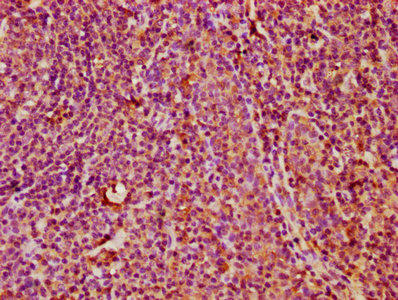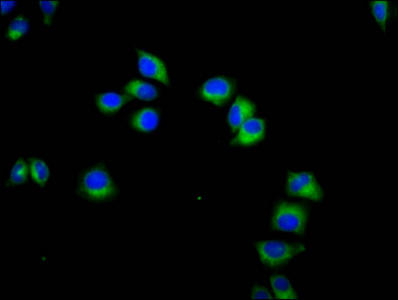Description
| Antibody Name: | KLRC3 Antibody (PACO59948) |
| Antibody SKU: | PACO59948 |
| Size: | 50ug |
| Host Species: | Rabbit |
| Tested Applications: | ELISA, IHC, IF |
| Recommended Dilutions: | ELISA:1:2000-1:10000, IHC:1:200-1:500, IF:1:50-1:200 |
| Species Reactivity: | Human |
| Immunogen: | Recombinant Human NKG2-E type II integral membrane protein (94-240AA) |
| Form: | Liquid |
| Storage Buffer: | Preservative: 0.03% Proclin 300 Constituents: 50% Glycerol, 0.01M PBS, pH 7.4 |
| Purification Method: | >95%, Protein G purified |
| Clonality: | Polyclonal |
| Isotype: | IgG |
| Conjugate: | Non-conjugated |
 | IHC image of PACO59948 diluted at 1:400 and staining in paraffin-embedded human tonsil tissue performed on a Leica BondTM system. After dewaxing and hydration, antigen retrieval was mediated by high pressure in a citrate buffer (pH 6.0). Section was blocked with 10% normal goat serum 30min at RT. Then primary antibody (1% BSA) was incubated at 4°C overnight. The primary is detected by a biotinylated secondary antibody and visualized using an HRP conjugated SP system. |
 | Immunofluorescence staining of Hela cells with PACO59948 at 1:133, counter-stained with DAPI. The cells were fixed in 4% formaldehyde, permeabilized using 0.2% Triton X-100 and blocked in 10% normal Goat Serum. The cells were then incubated with the antibody overnight at 4°C. The secondary antibody was Alexa Fluor 488-congugated AffiniPure Goat Anti-Rabbit IgG(H+L). |
| Background: | Plays a role as a receptor for the recognition of MHC class I HLA-E molecules by NK cells and some cytotoxic T-cells. |
| Synonyms: | NKG2-E type II integral membrane protein (NK cell receptor E) (NKG2-E-activating NK receptor), KLRC3, NKG2E |
| UniProt Protein Function: | KLRC3: Plays a role as a receptor for the recognition of MHC class I HLA-E molecules by NK cells and some cytotoxic T-cells. 2 isoforms of the human protein are produced by alternative splicing.Protein type: Membrane protein, integralChromosomal Location of Human Ortholog: 12p13Cellular Component: integral to membraneMolecular Function: transmembrane receptor activity; carbohydrate bindingBiological Process: cellular defense response; signal transduction |
| UniProt Protein Details: | |
| NCBI Summary: | Natural killer (NK) cells are lymphocytes that can mediate lysis of certain tumor cells and virus-infected cells without previous activation. They can also regulate specific humoral and cell-mediated immunity. NK cells preferentially express several calcium-dependent (C-type) lectins, which have been implicated in the regulation of NK cell function. KLRC3 is a member of the NKG2 group which are expressed primarily in natural killer (NK) cells and encodes a family of transmembrane proteins characterized by a type II membrane orientation (extracellular C terminus) and the presence of a C-type lectin domain. The NKG2 gene family is located within the NK complex, a region that contains several C-type lectin genes preferentially expressed on NK cells. Alternative splicing results in multiple transcript variants encoding different isoforms. [provided by RefSeq, Jul 2008] |
| UniProt Code: | Q07444 |
| NCBI GenInfo Identifier: | 75709175 |
| NCBI Gene ID: | 3823 |
| NCBI Accession: | NP_002252 |
| UniProt Secondary Accession: | Q07444 |
| UniProt Related Accession: | Q07444 |
| Molecular Weight: | 27kDa |
| NCBI Full Name: | NKG2-E type II integral membrane protein isoform E |
| NCBI Synonym Full Names: | killer cell lectin like receptor C3 |
| NCBI Official Symbol: | KLRC3 |
| NCBI Official Synonym Symbols: | NKG2E; NKG2-E |
| NCBI Protein Information: | NKG2-E type II integral membrane protein |
| UniProt Protein Name: | NKG2-E type II integral membrane protein |
| UniProt Synonym Protein Names: | NK cell receptor E; NKG2-E-activating NK receptor |
| Protein Family: | NKG2-E type II integral membrane protein |
| UniProt Gene Name: | KLRC3 |
| UniProt Entry Name: | NKG2E_HUMAN |






